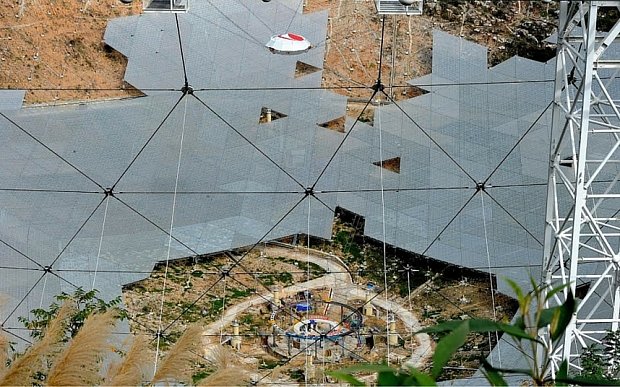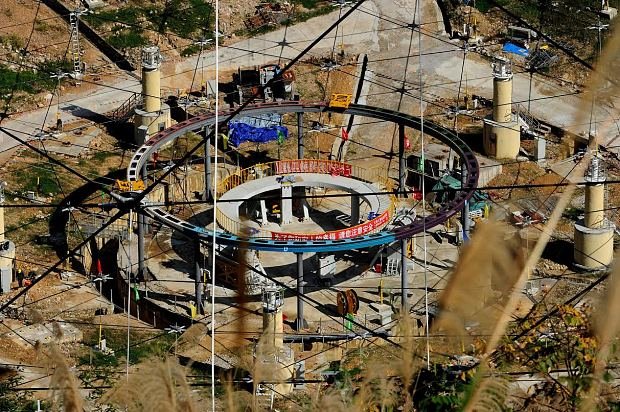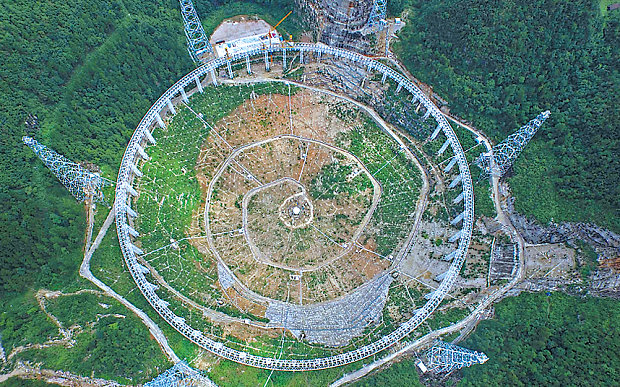With a dish the size of 30 football pitches, the telescope will scan for signs of life as far as tens of billions of light years away. It will be able to pick up radio signals distant galaxies and solar systems, and also hunt for future sources of energy like natural hydrogen.
"A radio telescope is like a sensitive ear, listening to tell meaningful radio messages from white noise in the universe," said Nan Rendong, the chief scientist at the project, known officially as the 500 Metre Aperture Spherical Telescope.
"It is like identifying the sound of cicadas in a thunderstorm."
Work on the telescope began in 2011 and is to be finished by September 2016. It will be substantially larger than the world's existing biggest star-gazer, the Arecibo Telescope in Puerto Rico, which was the setting for a secret electro-magnetic weapon in the 1995 James Bond film GoldenEye.
The telescope's home is in a rock basin in Pingtang County in south-west China's Guizhou Province, specially chosen for the natural recess it provides to protect the telescope from the elements. The basin's porous rock drains rainwater away quickly, while its distance from nearby towns ensures a high degree of "radio silence".

"It will help us to search for intelligent life outside of the galaxy and explore the origins of the universe," said Wu Xiangping, director-general of the Chinese Astronomical Society.
Li Di, a chief scientist from the Chinese Academy of Sciences told China Daily: "So far, one of the most important steps has been completed.
"We will finish installing all the panels by June 2016, and strive to debug the whole system by the end of September."

"With a larger signal receiving area and more flexibility, FAST will be able to scan two times more sky area than Arecibo, with three to five times higher sensitivity," he said.
It would take a full 40 minutes for the average person to walk around the telescope.
The enormous dish is made up of over 4,500 mostly triangular panels and its side panels measure 11 metres long.
As these pictures show, a retina was successfully installed inside the structure.
It was tested, and it works appropriately.
The massive reflector disk in the device will collect signals from the whole universe.
Astronomers have said that many new discoveries about space could be made using this piece of equipment.
Lister Staveley-Smith, an astronomer at the University of Western Australia, expects it to find unknown stars in the Milky Way other more distant galaxies.

The prospect of the discovering other life in space gained fresh scientific credence earlier this year, when Nasa discovered an 'earth-like' planet named Kepler-452b.
It was located about 1,400 light-years away from the solar system, and at the speed of a typical modern space craft, would take around 26 million years to reach from Earth. Nasa identified Kepler-452b as a rare example of a so-called "Goldilocks planet" - one that is capable of supporting human-style life because it is neither too close to the Sun nor too distant.
China is now on track to become a world leader in the space race, which its leaders view as confirmation of Beijing's growing superpower status.
In 2003, it became only the third nation in history to put a human into orbit. Since then, Chinese astronauts have walked in space, launched an orbital space lab and sent a lunar probe to the moon.
Should aliens ever choose to respond to any of the new telescope's radio signals, they might hear the phrase 有人吗 or Youren ma?
It translates roughly as "Is anybody out there?"




Reader Comments
to our Newsletter